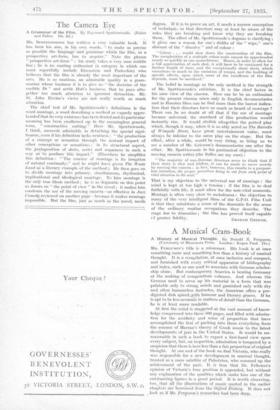The Camera Eye
A Grammar of the Film. By Raymond Spottiswoode. (Faber and Faber. 10s. 6d.) Mn. Seorriswoonn has written a very valuable book. It has been his aim, in his own words, " to make as precise as posSible the language anegranunar whiCh the film, as a prospectiye art-form, has to acquire." Note the phrase " prospective art-form " ; his study takes a very sane middle line ; he is no canting enthusiast (a category in which one must regretfully include Eisenstein and Pudovkin) , who believes that the film is already the most important of the arts. He is so cautious, an admirable quality in a gram- marian whose business it is to give us " the doctrine of the enclitic De" and settle Hoti's business, that he pays alto- gether too much attention to ignorant detraction. Mr. St. John Ervine's views are not really worth so much attention.
The chief test of Mr. Spottiswoode's definitions is the word montage, a word describing a method so vaguely appre- hendedthat its very existence has bee!' denied and its particular meaning has .been swallowed up in the meaningless general term, " constructive .r cutting," Here Mr. Spottiswoode, I think, succeeds admirably in detaching the special signi- ficance, leven if his ,definition leeks neatness : " the production of a concept or sensation through the mutual impact of other conceptions or sensations ; in its structural aspect, the juxtaposition of shots, series and sequences in such a way as to produce thii impact." (Elsewhere he simplifies this definition : " The essence of montage is its irruption of natural continuity," and he might have given The Waste Land aSa literary example of the method.) He then goes on to divide montage into primary, simultaneous, rhythmical, implications' and ideological montage.. To. him montage is the only true filmic method ; he is as dogmatic on this point as James on " the point of view " in the novel ; it makes him condenin the use of the moving' camera—so effective in Jazz Comedy reviewed on another page—because it makes montage impossible. But the film, just as Much as the 'novel, needs dggma. If it is to prove an art, it needs a narrow conception of technique, .So that directors may at least be aware of the rules they are breaking and know why they are breaking them. The effect of Mr. Spottiswoode's dogmas is clarifying ; it gives one a reason for one's dislike of the " wipe," one's distrust of the " dissolve " and of colour : " Colour . . . would slow down the construction of the film. The complexities of a multiple colour-scale cannot be apprehended nearly so quickly as can monochrome. Hence, in order to allow for a full appreciation of each shot, it will have to be continued 'for a further length of time, and the exceptionally short shots, which contribute so much to the variation of tempo, and the building of specific effects, upon which most of the excellence of the film depends, must be sacrificed."
The belief in montage as the only method is the strength of Mr. Spottiswoode's criticism. It is the chief factor in his' sane view of the cinema. How can he be an enthusiast for the present cinema when only in English documentaries and in Russian films can he find more than the barest indica- tion that their directors have so much as heard of montage ? There can ,,be no doubt at all that if the use of montage became universal, the standard of film production would instantly rise. It would abolish altogether the potted play which, though it may, when it is as ably acted as The Barrdts of Wimpole Street, have great entertainment value, must always be inferior to the same play on the stage. But the effect, after a while, would be very tiring, as tiring as to see a number of Mr. Grierson's documentaries one after the other. Mr. Spottiswoode in his puritanical objection to the moving camera writes (the italics are my own) : " The majority of non.Russian directors seem to think that if their story is slow and lifeless, it can be made to move merely by moving the camera ; in fact, however, this results in a purpose. less irritation, the proper procedure being to cut from eacli, point of vital attention to the next."
That is my objection to the universal use of montage : the mind is kept at too high a tension : if the film is to deal faithfully with life, it must allow for the non-vital moments.
Montage is often very close to melodrama : the objection to many of the very intelligent films of the G.P.O. Film Unit is that they substitute a sense of the dramatic for the sense of the ordinary routine occupations they describe. The stage has to dramatise ; the film has proved itself capable














































 Previous page
Previous page